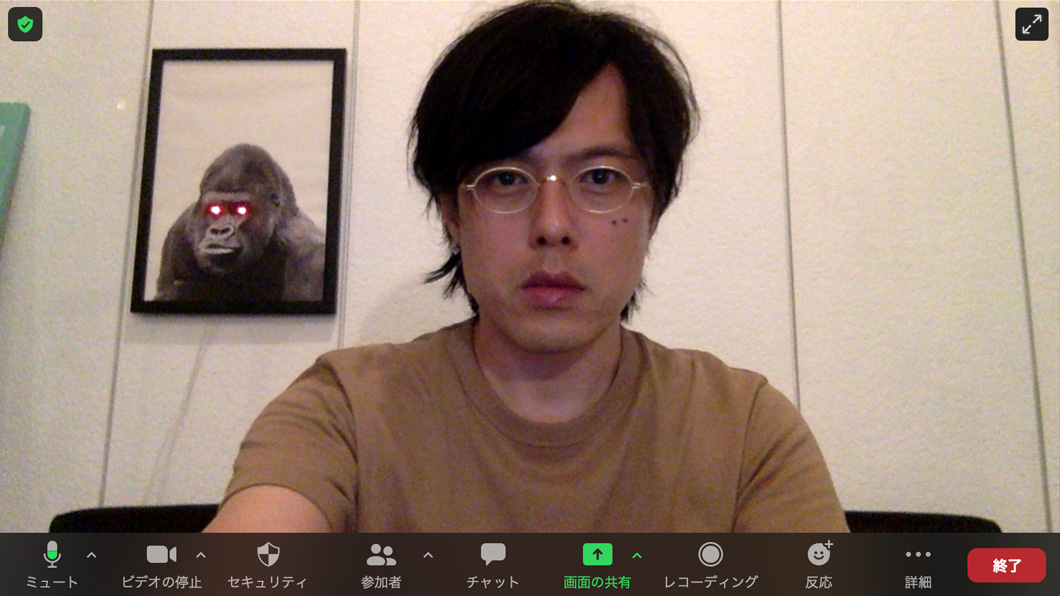
A series of four works that encourage exhibition and collaborative experiences over the internet, deployed via YouTube Live and held in a one-hour solo exhibition. Specifically, ‘Gorigai’, ‘Alive’, ‘openSE’ and ‘All the same face’ were exhibited, with participants committing themselves over the internet, which was facilitated by the artists themselves.
[more]

With the advent of the Corona disaster, online communication such as video calling and voice SNS has become more active. In such a situation, communication in online classes and talk delivery is divided into a speaker and a listener, and the interaction between the two is mainly through text such as chat. This work was created to increase the amount of traffic that the listener can interfere with the speaker under these circumstances, and to realize communication that is neither 0 nor 100.
Specifically, I built a web application that allows listeners to send their reactions and arbitrary words, and share these sound sources output from the speaker’s side with everyone through microphones and mixers. By constructing the input and output in a web browser, there is no need to install any kind of application, which is a feature that enhances accessibility.
In fact, when the application was introduced to university lectures, various talk transmissions, online workshops, etc., the users felt as if they were creating the distribution space together. This is thought to be a sense of presence created by the rapid stimulation of voice, a medium that differs from visual information processing such as language and stamps. In addition, voice has a high degree of intervention in the space and the speaker is forced to react, which creates a sense of satisfaction in the listener and encourages further interaction. Such characteristics have led to a reversal of the initiative from the broadcaster to the listener in the introduction of radio broadcasting.
Unlike “assertions” using symbols, such as chat and stamps, “openSE” provides “reactions” using voice, creating a space of mutual influence. In other words, it is a framework that creates a “collaborative experience” in virtual spaces.
[more]

Language is a highly convenient communication tool that streamlines cognitive processing and enables rapid communication. On the other hand, due to its high semantic resolution, it has the aspect of exacerbating the fragmentation among human individuals. This work is a system that reduces the resolution of the tool and focuses only on the desire to be connected to someone.
Specifically, I built a website that allows users to warp their own mouse cursor into real space via a web browser and communicate in real time with other people gathered there. Unlike online games, where the situation is recreated by the client, this website is characterized by the ability to share actual time and space.
The feedback from the participants was about the sense of touch. When they placed the mouse cursor over the various components that made up the room, they felt as if they could feel the texture of each component, and when they overlapped with the mouse cursor of another person, they felt as if they were touching each other and had a comfort zone. It is interesting to note that the interaction also encouraged mirroring, such as following and aligning. Furthermore, when I added a function that allowed the user to leave traces, it was impressive that the remaining player wandered around the traces when one of them left, showing a movement reminiscent of a regretful farewell.
The sense of touch observed in this work are thought to be the activation of the functional areas of the brain that control bodily sensations through the interaction of the participants with the visual feedback of the mouse cursor. The mimicry of movement and traces is an intrinsic behavior of living organisms that show favoritism toward the preservation of the group/species, and the fact that this behavior is facilitated through a computer network may provide an important cognitive scientific basis for the digitization of the experience of the work itself.
Website(PC)
https://alive.salon
Award
Tokyo TDC Annual Awards 2022 Selected Work
Media
VOGUE JAPAN
NHK World “Design Talks Plus”
[more]

In March of 2020, when the Corona disaster struck, the class I was supposed to teach as a part-time lecturer went entirely online. Since I could no longer share the real space with the students, I came up with the idea of creating a system that would allow everyone to directly interact with my space online. So, during the class, I set up a poster of a gorilla in the background of my Zoom, which could be controlled remotely via a web browser (the gorilla’s eyes would light up and the sound of a conch would ring out). This enabled communication that transcended space.
[more]

This work is a system whereby the artist prints a doodle of a face he has suddenly drawn on canvas, and visitors can anonymously post the title of the caption of the work from their own smartphones. The base is the website “It’s all the same face” ( https://onaji.org/ ), which is a site for posting interpretations of faces, and the latest postings are reflected in the caption each time. The interpretation of each viewer, which is updated and shared at will, becomes the official work title of the face, placing the artist and the viewer on the same layer, while the viewers also interact with each other, and everyone committed to the work forms a complicity relationship.
YouTube
[more]





